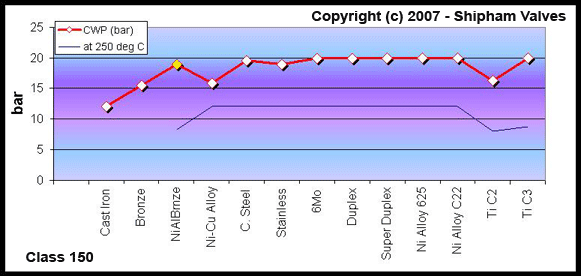
The chart shows the cold working pressure (CWP) for the various materials.
The comparison is not straightforward because the bronze and cast iron
figures relate only to flat-face flanges and all the other dimensions
relate to the ANSI B16.5 raised face dimensions. This fact will be discussed
in more detail later as will the fact that the NAB and titanium ratings
have been specially calculated.
A comparison between the pressure-ratings and the mechanical properties shows that the difference between the various materials has been flattened. The way the ratings are determined imposes an upper limit on the pressure, a ceiling is applied in order to limit deflection. The materials affected by this ceiling figure are 6Mo, the duplexes and Ni alloys
For comparison, the rating at 250oC is included. This illustrates the shortcomings of copper alloys at raised temperatures. Whilst there is no rating for bronze, NAB is less than most of the other materials, as are the titaniumís. The maximum temperature and pressure for each material is given in Appendix II. The difference between materials is further reduced by the use of ceiling values at higher pressures.
Mechanically, NAB can be seen to compare well enough to compete with its rivals. There is a limitation once high temperature performance is considered, however this is not generally an issue for seawater service.